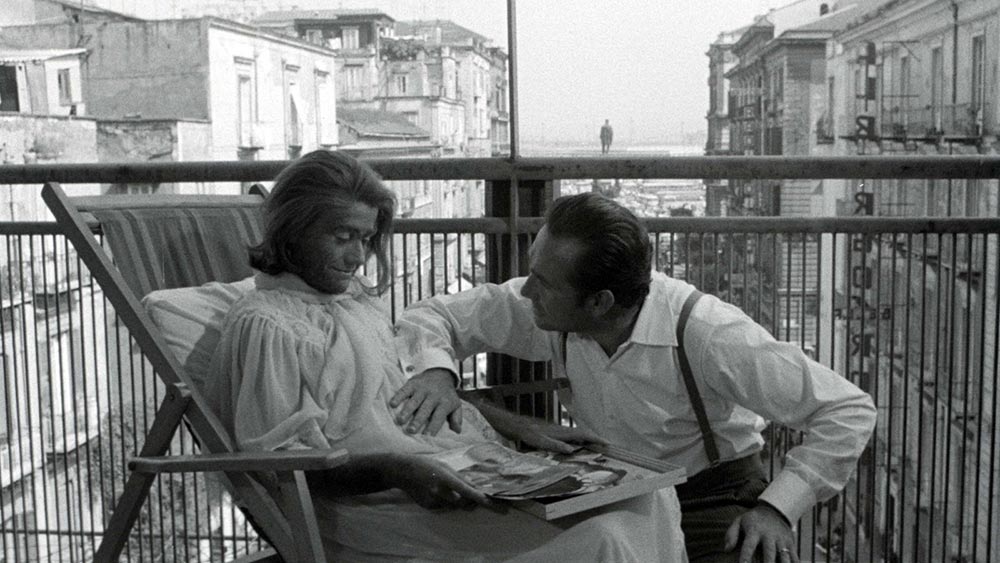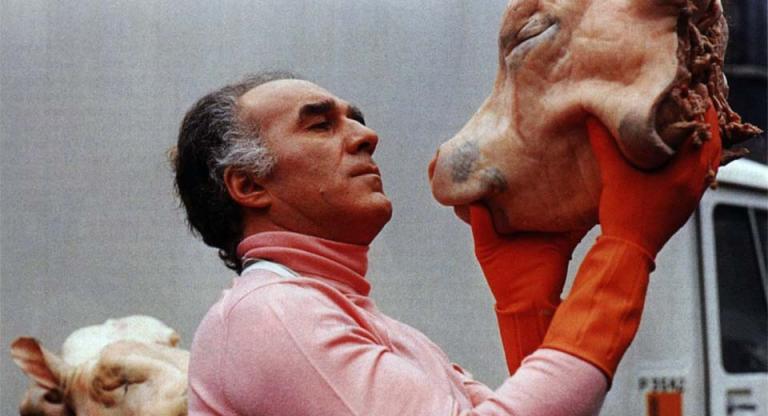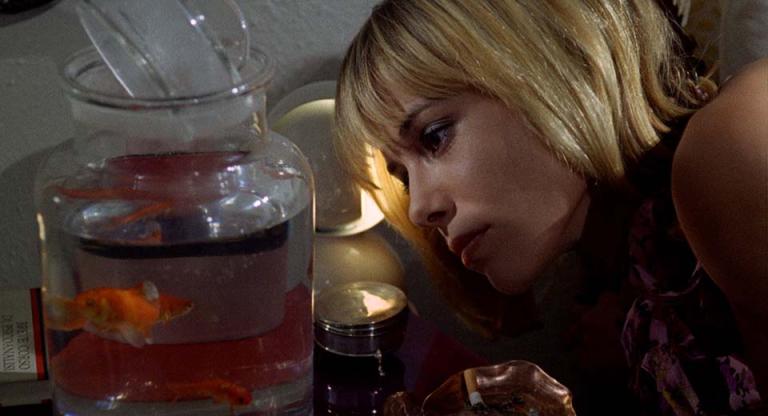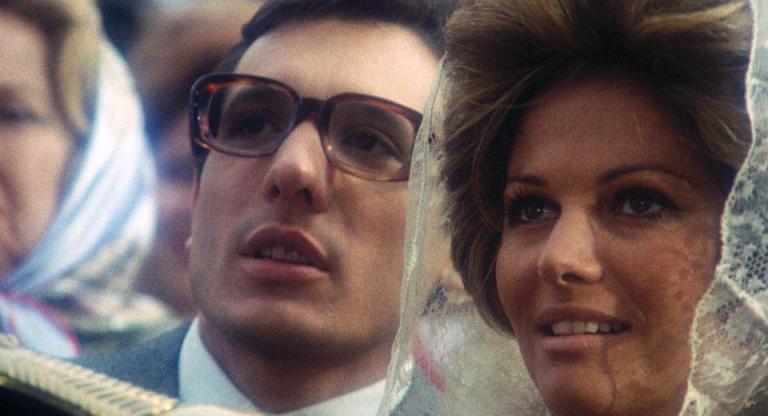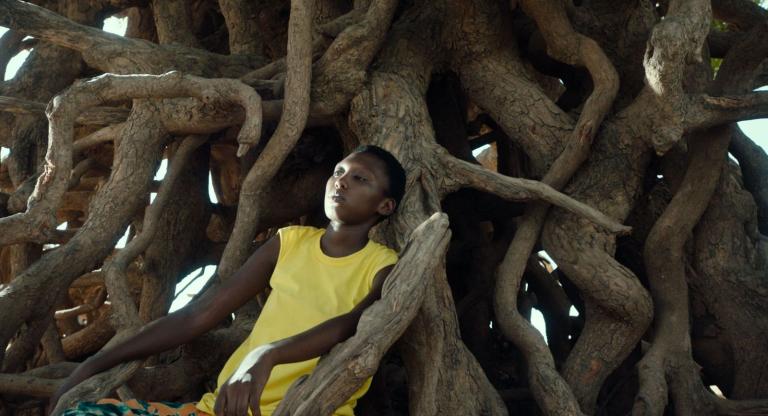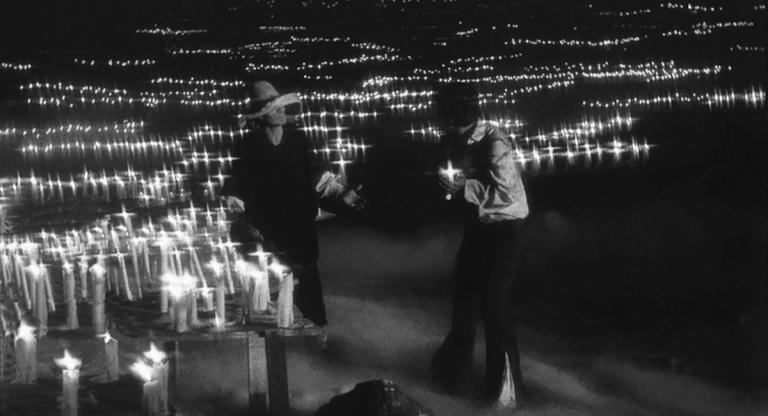Marco Ferreri’s The Ape Woman (1964) begins in a convent cafeteria, with the hungry penitents made to watch an edifying slideshow before their meal. The “scientific film” shows a missionary interacting with bare-chested Black women, much to the delight of the audience. As the narrating priest explains, “God weeps as long as there is one pagan on the earth,” particularly when, as is depicted in the concluding slide, said pagan decapitates the missionary, whose face—that of Ferreri—is crudely pasted into the image. Such is the biting humor of the tale about to unfold, in which an entrepreneurial “impresario” discovers a young woman covered in hair, creates a successful sideshow around her, marries her to keep the business afloat, and brings her to Paris to perform a jungle expedition–themed striptease.
Antonio (Ugo Tognazzi), our enterprising sideshow creator, first meets Maria (Annie Girardot) in the convent kitchen, where a seemingly preternatural sense of the retiring young woman’s potential drives him to corner her and push her to reveal herself. As he wheedles and she demures, the camera slowly moves closer: our desire to behold the “ape woman” ourselves is as fervent as his. To his delight, she is both covered in coarse hair head to toe, and beautiful. In a detail that flits by and is a testament to Tognazzi’s endlessly charismatic, aerobic performance, his mind appears to drift momentarily as he projects his lips suggestively, before his attention returns to cajoling Maria. She relishes the opportunity to lead an adult life of her own, as is demonstrated when we meet the two in their shared performance/living space: Antonio moves as constantly as he speaks, swinging from ropes and an artificial tree, happy to essentially shit where he eats; Maria, whose tidy little room is decorated with all the feminine accoutrement, prefers to make the minestrone rather than perfect her performance. The film’s opinion of who is the “ape” is clear.
Where the villain of this story is apparently Antonio, Maria’s constantly conniving exploiter, the film as insistently points a condemning finger elsewhere (and everywhere), for would such a man and his sideshow presentations exist were it not for the paying audiences, eager to fondle Maria’s hair? And though the Mother Superior stands firm that she cannot allow Maria to persist in this dissolute lifestyle with a money-hungry bachelor, as soon as he marries Maria the young woman is swiftly relinquished to her husband’s possession. The church, after all, suggested the very narrative structure of Maria’s performances with its scientific slideshow, a colonial fantasy of threatening, enticing sensuality and untamed violence countered by the alluring power of a good Catholic man in khaki. And we, too, have paid for a ticket to see the Ape Woman.
To be sure, Antonio is, as Maria eventually declares him, a monster, no more so than when he haggles with a “professor” on the price of a few days to explore the virginal “phenomen.” But the chemistry between the two builds into a sweetly domestic romance following her insistence that they consummate their marriage. Her tears throughout her bridal “parade”; a tender intimacy shared in their morning robes; Maria’s bold, seductive performance in Paris: Tognazzi and Girardot’s performances resist a straightforward hero-victim dichotomy. The exploitation is, after all, structural, and all around. Though The Ape Woman aims for a tone less devastating than that of David Lynch’s The Elephant Man (1980), which takes inspiration from Ferreri, it is similarly rich with an insistent, if always imperfect, humanity.
In its initial version, The Ape Woman follows quite closely the life of Julia Pastrana, an indigenous woman from Mexico born with hypertrichosis, a genetic condition which resulted in her body being covered in hair, and what is now thought to be gingival hyperplasia, which caused the distension of her teeth and nose. After being brought to the United States in the 1850s, Pastrana eloped with a man named Thomas Lent, who toured the country and Europe with the talented “Nondescript,” per one of her nicknames, for “freak show” performances and medical examinations (including by Charles Darwin). This tour persisted beyond her death, which followed that of her newborn son by days, their bodies preserved through a bizarre form of taxidermy and enjoyed by audiences worldwide. Her remains were finally given a proper burial in 2013, as featured in Eva Aridjis’s documentary Chuy, The Wolf Man.
Lincoln Center’s screenings of The Ape Woman will include all three endings produced for the film. Apparently, the original conclusion was deemed too bleak, and some especially cruel aspects were cut; then, a longer, more pedestrian ending was devised for wide release. It’s a testament to Ferreri and screenwriter Rafael Azcona’s talents—and unwavering indignation—that each version offers lasting, complicated critiques.
The Ape Woman screens this evening, June 11, and on June 17, at Film at Lincoln Center as part of the series “Marco Ferreri: Beyond the Absurd.”
